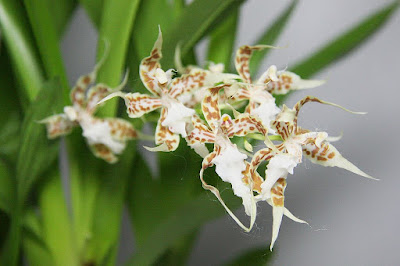Odontoglossum crocidipterum is native to Colombia, Venezuela and Peru. In Colombia, they are meet in several locations in the Eastern Andes Cordillera, in the departments of Santander and Cundinamarca, where they grow on trees in the clear stands of the upper parts of the rainforest, at heights 2000-2600 m...
Odontoglossum crocidipterum also called as The Saffron Yellow Two Winged Odontoglossum, Odontoglossum crocidipterum subsp. dormanianum, Odontoglossum dormanianum, Oncidium crocidipterum, is a species of the genus Odontoglossum. This species was described by Heinrich Gustav Reichenbach in 1871.
IDENTIFY ODONTOGLOSSUM CROCIDIPTERUM
Odontoglossum crocidipterum is native to Colombia, Venezuela and Peru. In Colombia, they are meet in several locations in the Eastern Andes Cordillera, in the departments of Santander and Cundinamarca, where they grow on trees in the clear stands of the upper parts of the rainforest, at heights 2000-2600 m. They are also found in the damp forest at an altitude of 1350 m, near Maracay in the coastal mountains on north, in the Henri Pittier National Park in the state of Aragua. In Venezuela, they were found in the northern mountains of Falcon and Lara at an altitude of 1400-1500 m and near Mérida and Boconó, where Dunsterville and Garay (1966) found them growing in rainforest at an altitude of 2290-2740 m.
It is a small to medium sized, cold growing epiphyte, which reaching 38 cm in height, with ovoid to ellipsoid, purple spotted, up to 6 cm long and 3 cm wide pseudobulbs enveloped basally by several pairs of distichous, imbricating sheaths with the uppermost being leaf-bearing carrying 2 apical, oblong to linear-lanceolate, acute, up to 25 cm long and 2.5 cm wide leaves.
The Saffron Yellow Two Winged Odontoglossum blooms in the winter on an ascending or arching, 20 cm long, racemose or paniculate, inflorescence with fragrant, small flowers arising on a newly maturing pseudobulb. The flowers are up to 7 cm in diameter. The typical form has yellow flowers, while those that have the petals of both milky-white whorls are known as the subspecies. They are densely covered with cinnamon-brown or dark-brown spots that can be combined on the outer whale's petals. The inner coat flakes have red-brown stripes at the bases. The lip has the same basic color as the petals of both whorls but has a generally dark yellow color at the base. It has red-brown stripes on side plots and a large brown spot on the top part of the middle plot. The rod and the anther chamber are white.
ODONTOGLOSSUM CROCIDIPTERUM CARE AND CULTURE
Cultural information should only be used as a guide, and should be to be adapted to suit you. Your physical location; where you grow your plants, how much time you have to devote to their care, and many other factors, will need to be taken into account. Only then can you decide on the cultural methods that best suit you and your plants.
Light:
Odontoglossum crocidipterum needs a light level of 15000-23000 lux.
Temperature:
The average temperature of the day throughout the year is 20-22 ° C, night 11-12 ° C, giving a daily difference of 8-11 ° C.
Humidity:
For most of the year, The Saffron Yellow Two Winged Odontoglossum needs the humidity of almost 70% and rises to about 75% in the period of 2 autumn months.
Substrate, growing media and repotting:
These plants are generally grown in pots. A loose, fast-drying substrate is required.
Watering:
During active growth, the plants should be watered frequently, but excellent drainage should be ensured, and the substrate around the roots should dry somewhat between waterings.
Fertilizer:
During the active growth of the plants should be fertilized every week 1/4-1/2 of the recommended dose of fertilizer for orchids.
Rest period:
In winter, Odontoglossum crocidipterum need less water, especially the plants grown in dark, short days at moderate latitudes, but they should not dry out completely. Fertilization should be reduced or eliminated until spring, when the amount of water increases when watering. However, if the pseudobulbs get too wrinkled, then the amount of water should be increased.















COMMENTS